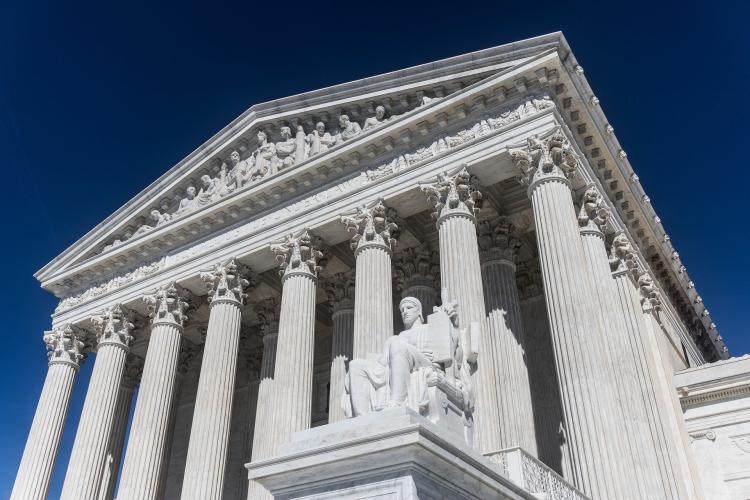What’s next for voting rights after Supreme Court ruling?

The U.S. Supreme Court building (credit: Pixabay)
On July 1, the U.S. Supreme Court voted to uphold two contentious laws in Arizona that impose restrictions on voting: one that required election officials to discard ballots cast at the wrong precinct and another that prohibits people from collecting ballots and delivering them to polling places. The move paves the way for states to pass more rigid voter laws that many fear will restrict participation from minority groups.
The ruling calls into question the effectiveness of the Voting Rights Act of 1965, which was implemented in part to protect voting access for minority groups. Doug Spencer, a professor of election law at Colorado Law, explains how the Supreme Court came to the ruling and what it means for the future of voting rights in the United States.

Professor Doug Spencer
What happened?
The plaintiffs in Arizona argued that two provisions of the state’s election law violated the federal Voting Rights Act (VRA), because the provisions had a disparate impact on minority voters.
The VRA forbids states from passing election laws “which result in a denial or abridgment of the right to vote...on account of race or color.” This clause is often referred to as the “results test.” Previously, the VRA had only ever been interpreted in cases dealing with vote dilution (like redistricting) and never in cases dealing with vote denial (like voter ID, ballot harvesting). As a result of several cases, the Supreme Court has ruled that the “results test” does not apply to cases of vote dilution. This means plaintiffs must show that any disparate impact on minority voters either interacted with social and historical conditions, or was the product of intentional and targeted discrimination.
In the most recent case, known as the Brnovich case, plaintiffs argued vote denial cases were different and that it should be enough to show that minority communities were disproportionately impacted by a state’s election law, regardless of the state legislature’s intent. The Supreme Court rejected this argument.
Most election law scholars (myself included) anticipated this outcome. The conservative Justices on the Supreme Court have been loudly and repeatedly skeptical of disparate impact standards in other civil rights cases such as housing discrimination and employment discrimination. But what was unclear before last week was just what kind of evidence the Supreme Court thinks should be introduced to show a violation of the VRA in vote denial cases.
How does this ruling impact the future of voter restriction legislation?
In his majority opinion, Justice Alito provides a five-part test for plaintiffs in future cases. To prevail, plaintiffs must now provide evidence that (1) the burden on minority voters is severe, (2) the limit on voting was not widespread in 1982 when Congress penned the “results test,” (3) the law produced a significant racial disparity in practice, (4) voting across the state’s entire electoral system is not open, and (5) the state’s justification for the law is unwarranted.
In practice, this five-part test will be nearly impossible for plaintiffs to satisfy in the future, no matter where they live. In particular, because voting has become more accessible in every jurisdiction across the country since 1982, plaintiffs will have a hard time satisfying prongs three and four. But the final prong is perhaps the most important. So long as a state claims to have a good reason for limiting the right to vote, plaintiffs will lose. It doesn’t matter if the state’s justification is flawed, or if the state’s law isn’t actually congruent with the justification. So, for example, a state only needs to argue that it is trying to combat voter fraud and it will win, even if there is no evidence of voter fraud and even if the state’s law (e.g., dropping off a ballot in a neighboring precinct) has no relationship to fraud.
What grounds did the Court have to make that decision?
The majority based its decision on its reading of the text of the VRA. It is important to note that the Supreme Court did not say that the VRA itself was unconstitutional (which would have been quite extreme), only that the language of the VRA didn’t implicate the challenged laws in Arizona. This means that the ball is in Congress’s court. Congress has the power to amend the language of the VRA in a way that would overrule the Supreme Court’s decision. The House and Senate are both currently debating the John Lewis Voting Rights Advancement Act which would be the most natural vehicle for a congressional response.
Does this ruling jeopardize voting rights for minority groups in other states?
Yes. Because the Supreme Court said that it will basically defer to state legislatures in every case, and because state legislatures are increasingly passing restrictive voter laws that disproportionately impact minority communities, last week’s decision will prevent these communities from filing lawsuits to protect their rights. Instead, these minority communities will need to rely on the political process to protect their rights. The challenge, of course, is that it’s the political process that has made it more difficult for minority communities to have a voice.
Could voting laws in Colorado be affected?
Colorado is on the very forefront of voter accessibility. Colorado residents have the option to vote by mail, vote early, and to cast a provisional ballot if there are administrative errors at a polling place. None of these options were available to Colorado voters in 1982. In theory, the state legislature could roll back voting rights in Colorado quite significantly without any recourse in the courts.
I think a more important consideration is how last week’s ruling could be affected by Colorado’s voting laws. The very fact that Colorado’s accessible electoral system is free and fair, that Republicans and Democrats run successful campaigns in the state, and that voter confidence is very high, undermines the arguments in other states that easy access to the ballot is fraudulent, partisan, or dangerous.
Why aren't there standardized federal voting laws for all states to follow?
The U.S. Constitution explicitly grants authority to the states to run elections. This authority stems from deep reservations in the 1770s about the emerging federal government, and the idea that elections are local affairs and should be entrusted to those closer to the action. Thus, deference to state legislatures makes sense, even though the result is a patchwork of rules and regulations.
But there is one hugely important caveat: States cannot administer their elections in a way that discriminates against minority voters. The 15th Amendment to the Constitution makes this exceptionally clear: “The right of citizens of the United States to vote shall not be denied or abridged by the United States or by any State on account of race…” The purpose of the VRA was to operationalize this promise of political equality, and to prevent states from passing laws “which result in a denial or abridgment of the right to vote…on account of race or color.” The Supreme Court’s decision to defer to state laws that disproportionately deny the rights of minorities to vote is in tension with both the VRA and the U.S. Constitution.


